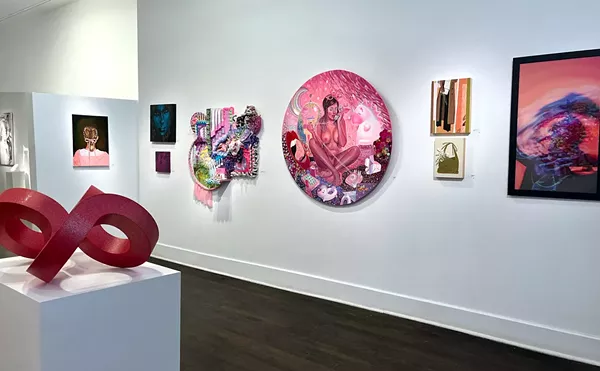
Audio By Carbonatix
[
{
"name": "GPT - Leaderboard - Inline - Content",
"component": "35519556",
"insertPoint": "5th",
"startingPoint": "3",
"requiredCountToDisplay": "3",
"maxInsertions": 100,
"adList": [
{
"adPreset": "LeaderboardInline"
}
]
}
]
“To go west or not to go west?” may be the question in the minds of art lovers in southeastern Michigan, lured by an 85-item Henry Moore exhibition on the other side of the state — but less enthusiastic about the two-and- a-half-hour road trip to get there.
To go would be wise. Inaugurating its 10th anniversary year, the Frederik Meijer Gardens and Sculpture Park in Grand Rapids, second city of Michigan, has set up an exhibit replete with the requisite bells and whistles to summon art mavens: eight monumental sculptures, a bevy of intermediate scaled bronzes, dozens of hand-sized maquettes, a generous array of drawings, prints and photographs, and an illuminating video of the British master himself (1898-1986), a defining sculptor of the 20th century. Henry Moore: Imaginary Landscapes, on view through May 8, is not a retrospective as one might expect, but an in-depth view of the second, or post-World War II, half of his career.
Before your field trip, stop by the Detroit Institute of Arts. Despite its paucity of art these days due to the renovation, the DIA is currently exhibiting a major carved wood sculpture by Moore from the first or pre-World War II era of his career. The museum’s “Reclining Figure” (standard appellation for many Moore recumbent females), which belongs to the artist’s first mature body of work and dates to 1939, stretches languorously 6 feet across. Indeed, she is one of the first objects visitors encounter as they move into the DIA galleries from the Woodward Avenue entrance lobby.
In Grand Rapids, however, scores of reclining Moores (no two alike) in both three and two dimensions are available for one to take the measure of Moore’s second, postwar creative wind. Organized by the Meijer Sculpture Park’s curator, Joseph Becherer, in collaboration with the Henry Moore Foundation in Perry Green, England, the show posits a rather déjà vu thesis, namely that Moore was deeply inspired by the natural landscape and that his forms, relaxed albeit watchful maidens, become part of the landscape as the landscape becomes part of them. Regrettably, this thesis is untestable, since all but one are installed in the indoor exhibition galleries, leaving both art and viewers imprisoned by the Michigan winter.
This familiar theme is, however, handsomely freshened by the focused selection of works dating mainly from the ’60s and ’70s, and by the elucidation of the artist’s formal breakthrough: the fragmenting of his supine figures into two or three discrete components aligned scant inches apart. For Moore, this rendered his figures even more like rugged, discontinuous landscapes. In contrast, the DIA’s reclining amazon is a single, unitary form.
A generous sampling of two-dimensional works — drawings, prints and photographs — reinforces and corroborates, if one needs convincing, Moore’s abiding affection for natural terrain. “Knees and breasts are mountains,” he declared in 1962, an analogy as evident in Detroit’s 1939 example as in the many later works of Moore’s oeuvre on view in Grand Rapids.
The exhibition also offers evidence that rocky, undulating topography was not Moore’s only organic source of inspiration. Flints, pebbles, shells, tree bark, icebergs, soup bones, an elephant skull, grottoes, Stonehenge, sea cliffs, driftwood, a fractured and fallen stone statue, and animal vertebrae all yielded forms, contours and textures for his sculptural practice. In fact, at least one of his first two-piece locking pieces, circa 1960, was inspired by “two pebbles which I was playing with and which seemed to fit each other and lock together.”
In a sketch, “Two Piece Reclining Figure” from 1961-62, Moore tries out three variations on his interlocking figures in which both the drawn forms outlined in black and the white, gestural strokes that violate the contours, establish an electrically charged field of energy between the separate but reciprocal forms. Their gestalt might even bring to mind Michelangelo’s “Creation of Adam” from the Sistine Chapel ceiling, in which the languid Adam is a nanosecond from being zapped to life by the Creator’s jabbing index finger.
Such suggestive ideas rendered in sketchbooks and as models frequently materialized on a grand scale in numerous two- and three-unit works of the ’60s and ’70s. In the Meijer Park show “Two Piece Reclining Figure: Points” (1969-1970) rises 6 feet in height and extends horizontally some 12 feet. The grandest of all of these behemoths, the 1965 “Reclining Figure: Lincoln Center” in New York (not in the show), measures some 28 feet in length, and is represented in the Sculpture Park’s display by “Working Model for Reclining Figure: Lincoln Center,” modestly spanning a mere 14 feet. (Incidentally, it is the largest work on view here.)
For Moore, these two- and three-part colossi added immeasurably to the visceral encounter with his work. “I realized what an advantage a separated two-piece composition could have in relating figures to landscape. If it is in two pieces, there’s a bigger surprise,” claimed Moore. “You have more unexpected views; therefore, the special advantage of sculpture over painting—of having the possibility of many different views—is more fully exploited.”
Moreover, big surprises await those who head west to a sculpture park comprising an enviable permanent collection of 160-plus works. The collection boasts an international roster of artists: Magdalena Abakanowicz, Deborah Butterfield, Keith Haring, Barbara Hepworth, Richard Hunt, Moore, Juan Muñoz, Louise Nevelson, George Rickey and Auguste Rodin.
Notably, the Park’s exhibitions have matured impressively over the last half-dozen years. The roll of one-person shows has included Haring, Hunt, Patrick Doherty, Rodin, Claes Oldenburg and Coosje van Bruggen, Abakanowicz, Louise Bourgeois and most recently George Segal and Mark di Suvero — high profile, solidly vetted artists all.
More serendipity for day-trippers: The city of Grand Rapids is rich in sculptural art as well. Alexander Calder’s vermilion stabile, “La Grande Vitesse,” glows in front of City Hall, a sculpted landscape by Maya Lin, “Ecliptic,” serves as a downtown gathering spot, and the Midwest’s only earthwork (except of course for the numerous Indian burial mounds found across the region, including Grand Rapids), “Project X” by Robert Morris in which the said letter forms two asphalt walkways that intersect halfway up a 260-feet-high hillside overlooking the city and the Grand River Valley.
So, with the sun warming your back both as you head west in the morning and east in the late afternoon, your round trip may perhaps be as epiphanic as Moore’s spirited description of circumnavigating one of his giantesses: “Sculpture is like a journey. You have a different view as you return. The three-dimensional world is full of surprises in a way that a two-dimensional world never could be.”
Through May 8 at the Frederik Meijer Gardens and Sculpture Park, 1000 E. Beltline NE, Grand Rapids. Call 616-957-1580 or visit meijergardens.org. Dennis Nawrocki is an art historian at the College for Creative Studies and the author of Art in Detroit Public Places. Send comments to letters@metrotimes.com





